- Joined
- Feb 28, 2019
- Messages
- 530
I imagine that this could be a somewhat subjective question with wildly varying responses.....
So let me start with some parameters:
I'm turning various steels on a 9" Southbend using hand ground HHS bits.
Diameters are reasonable ~2" or less
Steels are various, from unknown & store bought bolts to O1 drill rod.
I'm confident that my bits have proper shapes and relief and that they are sharp.
Initially, I would calculate speeds and feeds but now don't bother - do to my setup and comfort level, I found that I was typically well under suggested rates found in literature.
Recently I've been turning more steel, prior experience was mostly aluminum, brass and wood.
As I've become more comfortable with steel, I've been taking heavier roughing cuts - say .03 to .05 depth of cut at moderate rpm and feed. Because my lathe is not a monster lathe, I really can't cut that aggressively without bogging down or belt slippage (old lathe with flat belt run a little loose to crashes and jams less dramatic/damaging).
I try to turn dry and occasionally use cutting oil if it helps on the cut finish. Less mess. No coolant system - I doubt I need it.
So here's the question - If I'm dry cutting how much smoke should I expect?
Clearly any cut is going to generate some heat huge amounts of smoke means that the cut is likely too heavy. Adding oil will also increase the smoke - of course.
Based on the feel of the rough cut (sound, motor effort etc) and the temp of the part after (warmed up but comfortable to handle) - I don't think the cuts are too heavy.
So my conclusion is that if I'm getting clean cuts, and the lathe seems to be handling it, some smoke is to be expected.
What are your thoughts & experiences?
-Dave B
So let me start with some parameters:
I'm turning various steels on a 9" Southbend using hand ground HHS bits.
Diameters are reasonable ~2" or less
Steels are various, from unknown & store bought bolts to O1 drill rod.
I'm confident that my bits have proper shapes and relief and that they are sharp.
Initially, I would calculate speeds and feeds but now don't bother - do to my setup and comfort level, I found that I was typically well under suggested rates found in literature.
Recently I've been turning more steel, prior experience was mostly aluminum, brass and wood.
As I've become more comfortable with steel, I've been taking heavier roughing cuts - say .03 to .05 depth of cut at moderate rpm and feed. Because my lathe is not a monster lathe, I really can't cut that aggressively without bogging down or belt slippage (old lathe with flat belt run a little loose to crashes and jams less dramatic/damaging).
I try to turn dry and occasionally use cutting oil if it helps on the cut finish. Less mess. No coolant system - I doubt I need it.
So here's the question - If I'm dry cutting how much smoke should I expect?
Clearly any cut is going to generate some heat huge amounts of smoke means that the cut is likely too heavy. Adding oil will also increase the smoke - of course.
Based on the feel of the rough cut (sound, motor effort etc) and the temp of the part after (warmed up but comfortable to handle) - I don't think the cuts are too heavy.
So my conclusion is that if I'm getting clean cuts, and the lathe seems to be handling it, some smoke is to be expected.
What are your thoughts & experiences?
-Dave B

